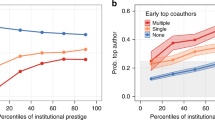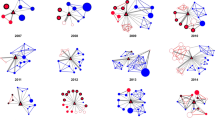Abstract
Collaboration is one of the key features in scientific research. With more and more knowledge accumulated in each discipline, individual researcher can only be an expert in some specific areas. As such, there are more and more multi-author papers nowadays. Many works in scientometrics have been devoted to analyze the structure of collaboration networks. However, how the collaboration impacts an author’s future career is much less studied in the literature. In this paper, we provide empirical evidence with American Physical Society data showing that collaboration with outstanding scientists (measured by their total citation) will significantly improve young researchers’ career. Interestingly, this effect is strongly nonlinear and subject to a power function with an exponent <1. Our work is also meaningful from practical point of view as it could be applied to identifying the potential young researchers.




Similar content being viewed by others
References
Acuna, D. E., Allesina, S., & Kording, K. P. (2012). Future impact: Predicting scientific success. Nature, 489(7415), 201–202.
Adams J. (2006). International Partnerships of Research Excellence. Available at http://go.nature.com/zzwn8z.
Adams, J. (2012). Collaborations: The rise of research networks. Nature, 490(7420), 335–336.
Albert, R., & Barabasi, A. L. (2002). Statistical mechanics of complex network. Reviews of Modern Physics, 74(1), 47–97.
Arajo, E. B., Moreira, A. A., Furtado, V., Pequeno, T. H. C., & Andrade, J. S. (2014). Collaboration networks from a large cv database: Dynamics, topology and bonus impact. PLoS ONE, 9(3), e90537.
Auriol, L. (2007). Labour market characteristics and international mobility of doctorate holders: Results for seven countries. OECD STI Working Papers, 2, 37.
Auriol, L. (2010). Careers of doctorate holders: Employment and mobility patterns. Oecd Science Technology & Industry Working Papers, 29(11–05), 15–23.
Auriol, L., Felix, B., & Fernandez-Polcuch, E. (2007). Mapping careers and mobility of doctorate holders: Draft guidelines, model questionnaire and indicators. OECD Science Technology & Industry Working Papers.
Bgelund, P. (2015). How supervisors perceive PhD supervision—And how they practice it. International Journal of Doctoral Studies, 10, 39–55.
Biesenbender, S., & Hornbostel, S. (2016). The research core dataset for the German science system: Developing standards for an integrated management of research information. Scientometrics, 108(1), 401–412.
Chen, Y., Borner, K., & Fang, S. (2013). Evolving collaboration networks in scientometrics in 1978–2010: A micro-macro analysis. Scientometrics, 95(3), 1051–1070.
Clauset, A., Arbesman, S., & Larremore, D. B. (2015). Systematic inequality and hierarchy in faculty hiring networks. Science Advances, 1(1), e1400005.
Cronin, B. (2001). Hyperauthorship: A postmodern perversion or evidence of a structural shift in scholarly communication practices? Journal of the American Society for Information Science and Technology, 52(7), 558–569.
Damien, C., Arnaud, D., Catherine, L., & Mlanie, P. (2016). The impact of a researcher’s performance: An empirical analysis. PLoS ONE, 11(8), e0161281.
Deville, P., Wang, D., Sinatra, R., Song, C., Blondel, V. D., & Barabai, A. L. (2014). Career on the move: Geography, stratification, and scientific impact. Scientific Reports, 4, 4770.
Dorogovtsev, S. N., & Mendes, J. F. F. (2002). Evolution of networks. Advances in Physics, 51(4), 1079–1187.
Dorogovtsev, S. N., & Mendes, J. F. F. (2015). Ranking scientists. Nature Physics, 11, 882–883.
Ebadi, A., & Schiffauerova, A. (2015). How to become an important player in scientific collaboration networks? Journal of Informetrics, 9(4), 809–825.
Ebadi, A., & Schiffauerova, A. (2015). How to receive more funding for your research? Get connected to the right people!. PLoS ONE, 10(7), e0133061.
Golosovsky, M., & Solomon, S. (2012). Stochastic dynamical model of a growing citation network based on a self-exciting point process. Physical Review Letters, 109(9), 297–311.
Hemmings, B., & Kay, R. (2016). The relationship between research self-efficacy, research disposition and publication output. Educational Psychology, 36(2), 347–361.
Henriksen, D. (2016). The rise in co-authorship in the social sciences (1980–2013). Scientometrics, 107(2), 455–476.
Hirsch, J. E. (2005). An index to quantify an individual’s scientific research output that takes into account the effect of multiple coauthorship. Proceedings of the National Academy of Sciences of the United States of America, 102(46), 16569–16572.
Horta, H., & Santos, J. M. (2016a). The impact of publishing during PhD studies on career research publication, visibility, and collaborations. Research in Higher Education, 57(1), 28–50.
Horta, H., & Santos, J. M. (2016b). An instrument to measure individuals? Research agenda setting: The multi-dimensional research agendas inventory. Scientometrics, 108(3), 1243–1265.
Horta, H., Cattaneo, M., & Meoli, M. (2016). PhD funding as a determinant of PhD and career research performance. Studies in Higher Education. doi:10.1080/03075079.2016.1185406.
Jeong, H., Neda, Z., & Barabai, A. L. (2003). Measuring preferential attachment in evolving networks. EPL, 61(4), 567–572.
Jones, B. F., & Weinberg, B. A. (2011). Age dynamics in scientific creativity. Proceedings of the National Academy of Sciences of the United States of America, 108(47), 18910–18914.
Kemp, A. (2013). Collaboration vs. individualism: What is better for the rising academic? Qualitative Report, 18(100), 1–8.
Larivire, V. (2012). On the shoulders of students? The contribution of phd students to the advancement of knowledge. Scientometrics, 90(2), 463–481.
Lazer, D., Pentland, A., Adamic, L., Aral, S., Barabasi, A. L., Brewer, D., et al. (2009). Life in the network: The coming age of computational social science. Science, 323(5915), 721–723.
Lee, S., & Bozeman, B. (2005). The impact of research collaboration on scientific productivity. Social Studies of Science: An International Review of Research in the Social Dimensions of Science and Technology, 35(5), 673–702.
Levitt, J. M., & Thelwall, M. (2016). Long term productivity and collaboration in information science. Scientometrics, 108(3), 1103–1117.
Leydesdorff, L. & Milojevic, S. (2015). Scientometrics. In: J.D. Wright (editors-in-chief), International Encyclopedia of Social and Behavioral Sciences (2nd Edition), Section 8.5: Science and Technology Studies, Subsection 85030. Micheal Lynch (ed.), 21, 322–327.
Leydesdorff, L., & Wagner, C. S. (2009). International collaboration in science and the formation of a core group. Journal of Informetrics, 2(4), 317–325.
Ma, N., & Guan, J. (2005). An exploratory study on collaboration profiles of chinese publications in molecular biology. Scientometrics, 65(3), 343–355.
Makkonen, T., & Mitze, T. (2016). Scientific collaboration between ’old’ and ’new’ member states: Did joining the european union make a difference? Scientometrics, 106(3), 1193–1215.
Medo, M., Cimini, G., & Gualdi, S. (2011). Temporal effects in the growth of networks. Physical Review Letters, 107(23), 238701.
Newman, M. E. J. (2001). The structure of scientific collaboration networks. Proceedings of the National Academy of Sciences of the United States of America, 98(2), 404–409.
Newman, M. E. J. (2003). The structure and function of complex networks. SIAM Review, 45(2), 167–256.
Ossenblok, T. L. B., Verleysen, F. T., & Engels, T. C. E. (2014). Coauthorship of journal articles and book chapters in the social sciences and humanities. Journal of the Association for Information Science & Technology, 65(5), 882–897.
Perianes-Rodriguez, A., Waltman, L., & Eck, N. J. V. (2016). Constructing bibliometric networks: A comparison between full and fractional counting. Journal of Informetrics, 10(4), 1178–1195.
Petersen, A. M., & Penner, O. (2014). Inequality and cumulative advantage in science careers: A case study of high-impact journals. EPJ Data Science, 3(1), 24.
Peterson, G. J., Pressé, S., & Dill, K. A. (2010). Nonuniversal power law scaling in the probability distribution of scientific citations. Proceedings of the National Academy of Sciences of the United States of America,107(37), 16023–16027.
Petersen, A. M., Riccaboni, M., Stanley, H. E., & Pammolli, F. (2012). Persistence and uncertainty in the academic career. Proceedings of the National Academy of Sciences of the United States of America, 109(14), 5213–5218.
Pfeiffer, M., Fischer, M. R., & Bauer, D. (2016). Publication activities of german junior researchers in academic medicine: Which factors impact impact factors? BMC Medical Education, 16(1), 190.
Pinheiro, D., Melkers, J., & Youtie, J. (2012). Learning to play the game: Student publishing as an indicator of future scholarly success. Technological Forecasting & Social Change, 81(1), 56–66.
Ponomariov, B., & Boardman, C. (2016). What is co-authorship? Scientometrics, 109(3), 1939–1963.
Revesz, P. Z. (2014). A method for predicting citations to the scientific publications of individual researchers. In: International Database Engineering & Applications Symposium (pp. 9–18). ACM.
Salabubar, A., & Castell, M. (2017). Exploring the relationship between doctoral students' experiences and research community positioning. Studies in Continuing Education, 39(1), 16–34.
Solimano, A. (2008). The international mobility of talent. Oxford: Oxford University Press.
Sooryamoorthy, R. (2014). Publication productivity and collaboration of researchers in South Africa: New empirical evidence. Scientometrics, 98(1), 531–545.
Vespignani, A. (2009). Predicting the behavior of techno-social systems. Science, 325(5939), 425–428.
Waaijer, C. J. F., Benot, M., Sugimoto, C. R., & Vincent, L. (2016). Stability and longevity in the publication careers of U.S. doctorate recipients. PLoS ONE, 11(4), e0154741.
Wuchty, S., Jones, B. F., & Uzzi, B. (2007). The increasing dominance of teams in production of knowledge. Science, 316(5827), 1036–1039.
Yan, E. (2014). Topic-based PageRank: Toward a topic-level scientific evaluation. Scientometrics, 100(2), 407–437.
Zhao, Y., & Zhao, R. (2016). An evolutionary analysis of collaboration networks in scientometrics. Scientometrics, 107(2), 759–772.
Acknowledgements
This work is supported by the National Natural Science Foundation of China (Grant Nos. 61603046 and 61374175) and the Natural Science Foundation of Beijing (Grant No. 16L00077).
Author information
Authors and Affiliations
Corresponding author
Electronic supplementary material
Below is the link to the electronic supplementary material.
Rights and permissions
About this article
Cite this article
Qi, M., Zeng, A., Li, M. et al. Standing on the shoulders of giants: the effect of outstanding scientists on young collaborators’ careers. Scientometrics 111, 1839–1850 (2017). https://doi.org/10.1007/s11192-017-2328-8
Received:
Published:
Issue Date:
DOI: https://doi.org/10.1007/s11192-017-2328-8




